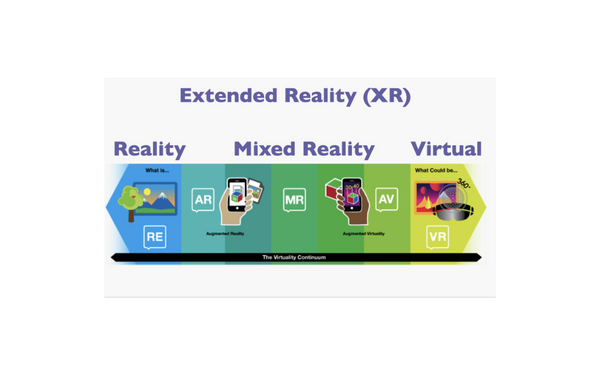Specific jargon abounds in the fields of augmented reality (AR), virtual reality (VR), and mixed reality (MR). Technologies such as spatial computing, wearable computing, ubiquitous computing, and the metaverse are also part of this field, in addition to MR and VR. There may be more by the time you read this.
There must be an agreement to define terminology and contexts before discussing “digital realities.” It may be time-consuming and frustrating to try to make sense of all the different words, which can dampen the enthusiasm and interest of anyone who isn’t an early adopter or inventor.
We are already seeing a gradual convergence of MR and VR technologies that will eventually result in their complete merging.
Because of this, we need to be succinct while discussing both broad and specific topics in the technological sphere, as well as when delving into finer points.
We don’t need to add to the already bloated language, therefore it’s a good thing we figured out how to control the jargon.
Commonly, “all real and virtual mixed settings and human-machine interactions” are referred to as “extended reality” (XR).
Consequences of an expanded reality continuum
In describing a digital reality realm, we use a continuum that has reality and virtual reality at opposite ends.
In between these two extremes lies mixed reality.
From a modern point of view, the lines between MR and reality, and reality and VR, are distinct.
There can be no compromise on the fact that the MR spectrum is inherently hazy and has no clear bounds.
While both real life and virtual reality may be thought of as discrete states, mixed reality is more accurately described as a non-linear gradient.
Or, to put it another way, the reality-virtual reality continuum beyond MR and VR. For convenience, we might refer to this region of the reality-virtuality continuum as the extended reality continuum.
Users, especially well-versed ones, will eventually become oblivious to the distinctions between MR and VR as a result of technological advances and better experience design.
Classifications based on the XR continuum will be meaningful only to the creators of the system.
The repercussions on user experience
It is intriguing to think that maybe the line between MR and VR won’t always be so clear.
In the first stages of the development of immersive digital experiences, we can already observe that they are fluid and not clearly MR or VR.
Concerns concerning the user experience may arise from the fact that MR and VR capabilities are shared.
Let’s assume for the sake of hypothesis testing that the technology to provide high-quality MR and VR experiences already exists. Any visor, whether it be Geordi La Forge’s (Star Trek: The Next Generation) or Darth Vader’s (Star Wars: The Phantom Menace) or the Mandalorian’s (Star Wars: The Force Awakens) or a contact lens (or eye replacements, like in Black Mirror’s “The Entire History of You”), would work (S1E3).
Thinking about how MXR will affect the design of experiences raises a number of pertinent issues.
In the XR continuum, what are the pros and cons of having a variety of experience postures?
Is it possible for a single experience to switch between MR and VR?
Is it possible for a single encounter to effectively span numerous points along the MR continuum?
How can we create MR environments that are really enhanced in nature?
Find out where on the XR spectrum your consumers’ ideal solution lies.
The following are some of my first conjectures.
Designers should take a stance on whether they are MR or VR and stick to it, but their assumptions should be tested and reassessed.
If transitioning between MR and VR is indeed conceivable, it will most likely occur through clearly defined modalities or occur so gradually that the user is unaffected.
Nonetheless, it’s certainly a design pitfall to try to combine MR and VR in a single experience.
Nothing can be done but guesswork and trial and error at this time.
But we may make informed guesses by drawing on the lessons of interactive experience design’s past.
Resulting hardware effects
The hardware of future devices will also reflect this duality.
A recent crop of exceptional gadgets, including Oculus, HoloLens, Magic Leap, and smartphones (iPhone, Android), all lean heavily in one one or the other when it comes to mixed reality and virtual reality.
There’s a logical reason why each gadget is designed to facilitate only one sort of experience and not both.
In addition to the aforementioned difficulties with experience design, there are also significant technological obstacles and potential changes to manufacturing costs associated with supporting both.
But things are changing, and newer models of devices will be able to handle both MR and VR content. Screen-based devices with passthrough camera capability include those from manufacturers like Varjo, Lynx, and Meta. To “see through the screen,” a device with passthrough functionality employs an external camera to record what is normally hidden from view. High-resolution MR and VR experiences are possible with the help of these gadgets.
The outer lens of the Magic Leap 2 (ML2) may be dimmed to produce a partially transparent image of the actual world.
This isn’t really an attempt to allow VR experiences, but rather an improvement to the visual quality of produced material.
Because of their restricted field of vision and inability to entirely filter out the actual environment, MR systems are not suited to the task of delivering a high-quality VR experience.
It’s simple to picture (and aspire for) a future when we don’t only have MR and VR devices, but XR devices that can enable any experience throughout the XR continuum.
Unfortunately, this might take a while, and it will probably necessitate new physical implementations.
Although, there will always be a demand for standalone MR and VR hardware.
Low-cost or solution-optimized hardware will continue to support only one type of virtual reality or augmented reality as the technologies become more widely available.

Subtly charming pop culture geek. Amateur analyst. Freelance tv buff. Coffee lover
